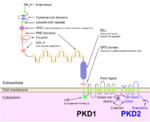Biology:Polycystin 1
Polycystin 1 (PC1) is a protein that in humans is encoded by the PKD1 gene.[1][2] Mutations of PKD1 are associated with most cases of autosomal dominant polycystic kidney disease, a severe hereditary disorder of the kidneys characterised by the development of renal cysts and severe kidney dysfunction.[3]
Protein structure and function
PC1 is a membrane-bound protein 4303 amino acids in length expressed largely upon the primary cilium, as well as apical membranes, adherens junctions, and desmosomes.[4] It has 11 transmembrane domains, a large extracellular N-terminal domain, and a short (about 200 amino acid) cytoplasmic C-terminal domain.[4][5] This intracellular domain contains a coiled-coil domain through which PC1 interacts with polycystin 2 (PC2), a membrane-bound Ca2+-permeable ion channel.
PC1 has been proposed to act as a G protein–coupled receptor.[4][6] The C-terminal domain may be cleaved in a number of different ways. In one instance, a ~35 kDa portion of the tail has been found to accumulate in the cell nucleus in response to decreased fluid flow in the mouse kidney.[7] In another instance, a 15 kDa fragment may be yielded, interacting with transcriptional activator and co-activator STAT6 and p100, or components of the canonical Wnt signaling pathway in an inhibitory manner.[8][9]
The structure of the human PKD1-PKD2 complex has been solved by cryo-electron microscopy, which showed a 1:3 ratio of PKD1 and PKD2 in the structure. PKD1 consists of a voltage-gated ion channel fold that interacts with PKD2.[10]
PC1 mediates mechanosensation of fluid flow by the primary cilium in the renal epithelium and of mechanical deformation of articular cartilage.[11]
Gene
Splice variants encoding different isoforms have been noted for PKD1. The gene is closely linked to six pseudogenes in a known duplicated region on chromosome 16p.[12]
References
- ↑ "The polycystic kidney disease 1 (PKD1) gene encodes a novel protein with multiple cell recognition domains". Nature Genetics 10 (2): 151–60. June 1995. doi:10.1038/ng0695-151. PMID 7663510.
- ↑ "Polycystic kidney disease: the complete structure of the PKD1 gene and its protein. The International Polycystic Kidney Disease Consortium". Cell 81 (2): 289–98. April 1995. doi:10.1016/0092-8674(95)90339-9. PMID 7736581.
- ↑ "Autosomal dominant polycystic kidney disease". Lancet 369 (9569): 1287–301. April 2007. doi:10.1016/S0140-6736(07)60601-1. PMID 17434405.
- ↑ 4.0 4.1 4.2 "Polycystins and primary cilia: primers for cell cycle progression". Annual Review of Physiology 71: 83–113. 2009. doi:10.1146/annurev.physiol.70.113006.100621. PMID 19572811.
- ↑ "Polycystin-1: function as a mechanosensor". The International Journal of Biochemistry & Cell Biology 42 (10): 1610–3. October 2010. doi:10.1016/j.biocel.2010.06.017. PMID 20601082.
- ↑ "The Role of G-Protein-Coupled Receptor Proteolysis Site Cleavage of Polycystin-1 in Renal Physiology and Polycystic Kidney Disease". Cells 5 (1): 3. January 2016. doi:10.3390/cells5010003. PMID 26805887.
- ↑ "Mechanical stimuli induce cleavage and nuclear translocation of the polycystin-1 C terminus". The Journal of Clinical Investigation 114 (10): 1433–43. November 2004. doi:10.1172/JCI21753. PMID 15545994.
- ↑ "Polycystin-1, STAT6, and P100 function in a pathway that transduces ciliary mechanosensation and is activated in polycystic kidney disease". Developmental Cell 10 (1): 57–69. January 2006. doi:10.1016/j.devcel.2005.12.005. PMID 16399078.
- ↑ "Polycystin-1 C-terminal tail associates with beta-catenin and inhibits canonical Wnt signaling". Human Molecular Genetics 17 (20): 3105–17. October 2008. doi:10.1093/hmg/ddn208. PMID 18632682.
- ↑ Shi, Yigong; Mei, Changlin; Zhou, Qiang; Wang, Tingliang; Yu, Shengqiang; Lei, Jianlin; Ge, Xiaofei; Hu, Feizhuo et al. (2018-09-07). "Structure of the human PKD1-PKD2 complex" (in en). Science 361 (6406): eaat9819. doi:10.1126/science.aat9819. ISSN 0036-8075. PMID 30093605.
- ↑ "Polycystins 1 and 2 mediate mechanosensation in the primary cilium of kidney cells" (in En). Nature Genetics 33 (2): 129–37. February 2003. doi:10.1038/ng1076. PMID 12514735.
- ↑ "Entrez Gene: PKD1 polycystic kidney disease 1 (autosomal dominant)". https://www.ncbi.nlm.nih.gov/sites/entrez?Db=gene&Cmd=ShowDetailView&TermToSearch=5310.
External links
 |



